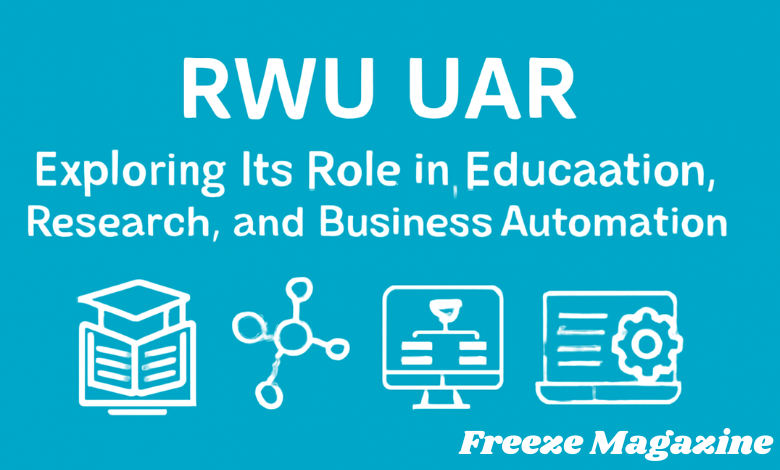RWU UAR: Exploring Its Role in Education, Research, and Business Automation
Introduction
In today’s rapidly evolving world, the term “RWU UAR” is gaining recognition across various domains such as education, research, business automation, and information technology. While the term may appear to be ambiguous at first glance, it encompasses a variety of systems, platforms, and institutions that play a significant role in shaping contemporary landscapes in both the academic and professional spheres. This article aims to provide a clear, detailed, and informative exploration of the term RWU UAR, its components, and its influence across different sectors.
What is RWU UAR?
RWU UAR is a broad term that spans multiple fields, particularly in education, research, and business automation. The acronym, though initially appearing obscure, represents a crucial combination of components that are shaping the way we approach innovation, learning, and efficiency. The term itself is rooted in both technical and institutional contexts, and understanding its meaning requires breaking down its various components.
To understand the full scope of RWU UAR, one must recognize its significance within specific areas like:
- Education and Research
- Business Automation and Information Technology
- Institutional Systems
Each of these areas contributes to the overall impact of RWU UAR, making it an essential tool for modern enterprises, educational institutions, and research-driven initiatives.
RWU UAR in Education
In the education sector, RWU UAR refers to systems and frameworks that help in the administration and management of educational institutions. These systems are designed to streamline processes such as student enrollment, academic performance tracking, faculty management, and resource allocation. Universities and colleges increasingly rely on these automated systems to handle large volumes of data efficiently.
One of the major advantages of RWU UAR systems in education is their ability to integrate various institutional processes into a single unified platform. This leads to improved operational efficiency, better decision-making capabilities, and enhanced communication between students, faculty, and administration.
For example, RWU UAR systems can be used to track student attendance, grades, and even extracurricular activities, providing a more holistic view of student performance. Furthermore, these systems help universities and colleges stay compliant with accreditation requirements and regulatory standards by maintaining accurate records.
Additionally, RWU UAR platforms play a crucial role in distance education, especially in light of the ongoing digital transformation in the educational sector. With the rise of online learning platforms and remote education, RWU UAR provides the necessary infrastructure to support virtual classrooms, e-learning modules, and online assessments. These platforms help in ensuring that both students and instructors can engage effectively in an online environment, making education more accessible and scalable.
RWU UAR in Research
The research sector also benefits significantly from RWU UAR systems. Research institutions, universities, and think tanks utilize these systems for data management, analysis, and dissemination of findings. In this context, RWU UAR refers to systems that help researchers collect, store, and analyze data in a secure and organized manner. These systems also enable collaboration across different teams, departments, and institutions.
In scientific research, data management is crucial. With the growing complexity of research projects, particularly in fields like biology, physics, and social sciences, researchers are increasingly turning to RWU UAR platforms to manage the large datasets they generate. These platforms offer tools for data cleaning, visualization, and analysis, which help researchers derive meaningful insights more efficiently.
Additionally, RWU UAR systems support the peer-review process by providing platforms for the submission, review, and publication of academic papers and research findings. These systems help to maintain a high standard of quality control in the dissemination of research, ensuring that only peer-reviewed, credible, and relevant studies are shared within the scientific community.
RWU UAR in Business Automation and Information Technology
Beyond education and research, RWU UAR is also a key player in the fields of business automation and information technology. In these domains, the term is often associated with automated systems that handle repetitive tasks, manage workflows, and facilitate decision-making processes. These systems are essential for improving efficiency, reducing operational costs, and enhancing productivity.
In business automation, RWU UAR platforms can be used for tasks such as customer relationship management (CRM), inventory control, human resources management, and financial operations. These systems help businesses streamline their operations by automating manual processes, reducing the likelihood of errors, and ensuring that resources are utilized effectively.
For instance, RWU UAR systems can automate tasks such as invoicing, scheduling, and employee performance tracking. By doing so, businesses can focus on more strategic activities, such as innovation, market expansion, and customer acquisition. Furthermore, these systems provide real-time analytics, which help organizations make data-driven decisions that improve their bottom line.
In the realm of information technology, RWU UAR systems are commonly integrated with cloud computing platforms and artificial intelligence tools to further enhance their capabilities. Cloud-based RWU UAR systems allow businesses to scale their operations seamlessly while maintaining access to the most up-to-date information and tools. Meanwhile, AI-powered RWU UAR systems help organizations analyze large datasets, predict trends, and automate decision-making processes with greater precision.
RWU UAR in Institutional Systems
At a more institutional level, RWU UAR encompasses the administrative systems and structures that govern educational institutions, research bodies, and business organizations. These systems are designed to ensure smooth operation and accountability within organizations, providing a central hub for managing everything from financial records to employee performance.
For educational institutions, RWU UAR systems provide a centralized platform for handling everything related to student admissions, registration, coursework, and graduation. These systems help ensure that all student-related processes are documented accurately and that relevant information is easily accessible to both students and staff.
In the corporate world, RWU UAR systems are used to manage human resources, payroll, and performance evaluations. By automating these administrative tasks, businesses can ensure that they comply with labor laws, maintain accurate financial records, and improve the overall employee experience.
The integration of RWU UAR systems into institutional processes also leads to better governance and transparency. For example, in universities, these systems enable administrators to track and manage financial aid disbursements, research funding, and budget allocation more efficiently. In businesses, these systems help ensure that financial and operational data is consistently up-to-date, reducing the risk of fraud and improving corporate accountability.
The Future of RWU UAR
As we look toward the future, it is clear that RWU UAR systems will continue to evolve and adapt to meet the needs of an increasingly digital world. The integration of emerging technologies such as artificial intelligence, machine learning, and blockchain will likely have a profound impact on the functionality and scope of these systems.
For example, in the education sector, AI-powered RWU UAR systems could help provide personalized learning experiences for students by analyzing their academic performance and tailoring lessons to their specific needs. In research, the use of blockchain technology could enhance data security and integrity, ensuring that research findings are protected from manipulation or tampering.
Moreover, the continued adoption of cloud computing and big data analytics will make RWU UAR systems even more powerful, enabling organizations to make real-time decisions based on vast amounts of data. This will lead to more efficient processes, better outcomes, and a more interconnected world.
Conclusion
RWU UAR is a multifaceted term that touches upon several important areas, including education, research, business automation, and institutional systems. These systems are playing a pivotal role in transforming how organizations and institutions manage operations, enhance productivity, and make decisions. As technology continues to advance, RWU UAR systems will only become more sophisticated, offering even greater benefits to the fields they serve.
By understanding the significance of RWU UAR, individuals and organizations can better appreciate the value these systems bring in creating more efficient, data-driven, and interconnected environments. Whether in a classroom, a research lab, or a business setting, RWU UAR represents the tools and platforms that are shaping the future of work, learning, and innovation.
FAQS
1. What does RWU UAR stand for?
RWU UAR refers to systems and platforms used in education, research, business automation, and institutional operations.
2. How does RWU UAR benefit educational institutions?
RWU UAR helps streamline administrative tasks, manage student data, and improve communication between students, faculty, and staff.
3. Can RWU UAR be used for business automation?
Yes, RWU UAR automates workflows, improves operational efficiency, and supports decision-making processes in various business functions.
4. How does RWU UAR enhance research data management?
RWU UAR helps researchers organize, analyze, and share large datasets, facilitating collaboration and improving the accuracy of research outcomes.
5. Is RWU UAR scalable for larger institutions?
Yes, RWU UAR systems are designed to scale with the growth of institutions, whether educational, research-based, or business-driven.





Post Comment